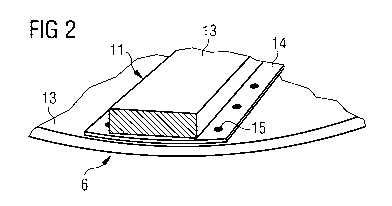Une partie des informations de ce site Web a été fournie par des sources externes. Le gouvernement du Canada n'assume aucune responsabilité concernant la précision, l'actualité ou la fiabilité des informations fournies par les sources externes. Les utilisateurs qui désirent employer cette information devraient consulter directement la source des informations. Le contenu fourni par les sources externes n'est pas assujetti aux exigences sur les langues officielles, la protection des renseignements personnels et l'accessibilité.
L'apparition de différences dans le texte et l'image des Revendications et de l'Abrégé dépend du moment auquel le document est publié. Les textes des Revendications et de l'Abrégé sont affichés :
| (12) Demande de brevet: | (11) CA 2789825 |
|---|---|
| (54) Titre français: | PROCEDE D'ASSEMBLAGE D'UNE PARTIE D'UN GENERATEUR, GENERATEUR ET TURBINE D'EOLIENNE |
| (54) Titre anglais: | METHOD FOR ASSEMBLING PART OF A GENERATOR, GENERATOR AND WIND TURBINE |
| Statut: | Réputée abandonnée et au-delà du délai pour le rétablissement - en attente de la réponse à l’avis de communication rejetée |
| (51) Classification internationale des brevets (CIB): |
|
|---|---|
| (72) Inventeurs : |
|
| (73) Titulaires : |
|
| (71) Demandeurs : |
|
| (74) Agent: | SMART & BIGGAR LP |
| (74) Co-agent: | |
| (45) Délivré: | |
| (86) Date de dépôt PCT: | 2010-02-16 |
| (87) Mise à la disponibilité du public: | 2011-08-25 |
| Requête d'examen: | 2014-10-07 |
| Licence disponible: | S.O. |
| Cédé au domaine public: | S.O. |
| (25) Langue des documents déposés: | Anglais |
| Traité de coopération en matière de brevets (PCT): | Oui |
|---|---|
| (86) Numéro de la demande PCT: | PCT/EP2010/000961 |
| (87) Numéro de publication internationale PCT: | WO 2011100987 |
| (85) Entrée nationale: | 2012-08-14 |
| (30) Données de priorité de la demande: | S.O. |
|---|
L'invention concerne un procédé d'assemblage d'une partie d'un générateur (6). Selon l'invention, un système (11) d'aimant comprenant au moins un aimant (13) et une plaque de montage (14) est attaché à un élément de base (12) par soudage (15) de la plaque de montage (14) à l'élément de base (12).
A method for assembling part of a generator (6) is provided, wherein a magnet assembly (11) comprising at least one magnet (13) and a mounting plate (14) is fastened to a base element (12) by welding (15) the mounting plate (14) to the base element (12).
Note : Les revendications sont présentées dans la langue officielle dans laquelle elles ont été soumises.
Note : Les descriptions sont présentées dans la langue officielle dans laquelle elles ont été soumises.

2024-08-01 : Dans le cadre de la transition vers les Brevets de nouvelle génération (BNG), la base de données sur les brevets canadiens (BDBC) contient désormais un Historique d'événement plus détaillé, qui reproduit le Journal des événements de notre nouvelle solution interne.
Veuillez noter que les événements débutant par « Inactive : » se réfèrent à des événements qui ne sont plus utilisés dans notre nouvelle solution interne.
Pour une meilleure compréhension de l'état de la demande ou brevet qui figure sur cette page, la rubrique Mise en garde , et les descriptions de Brevet , Historique d'événement , Taxes périodiques et Historique des paiements devraient être consultées.
| Description | Date |
|---|---|
| Inactive : CIB expirée | 2022-01-01 |
| Demande non rétablie avant l'échéance | 2017-07-04 |
| Inactive : Morte - Aucune rép. dem. par.30(2) Règles | 2017-07-04 |
| Réputée abandonnée - omission de répondre à un avis sur les taxes pour le maintien en état | 2017-02-16 |
| Inactive : Abandon. - Aucune rép dem par.30(2) Règles | 2016-07-04 |
| Inactive : Dem. de l'examinateur par.30(2) Règles | 2016-01-04 |
| Inactive : Rapport - Aucun CQ | 2015-12-17 |
| Requête pour le changement d'adresse ou de mode de correspondance reçue | 2015-01-15 |
| Lettre envoyée | 2014-10-17 |
| Exigences pour une requête d'examen - jugée conforme | 2014-10-07 |
| Requête d'examen reçue | 2014-10-07 |
| Toutes les exigences pour l'examen - jugée conforme | 2014-10-07 |
| Inactive : Page couverture publiée | 2012-10-25 |
| Demande reçue - PCT | 2012-09-28 |
| Inactive : Notice - Entrée phase nat. - Pas de RE | 2012-09-28 |
| Inactive : CIB attribuée | 2012-09-28 |
| Inactive : CIB attribuée | 2012-09-28 |
| Inactive : CIB en 1re position | 2012-09-28 |
| Exigences pour l'entrée dans la phase nationale - jugée conforme | 2012-08-14 |
| Demande publiée (accessible au public) | 2011-08-25 |
| Date d'abandonnement | Raison | Date de rétablissement |
|---|---|---|
| 2017-02-16 |
Le dernier paiement a été reçu le 2016-01-13
Avis : Si le paiement en totalité n'a pas été reçu au plus tard à la date indiquée, une taxe supplémentaire peut être imposée, soit une des taxes suivantes :
Veuillez vous référer à la page web des taxes sur les brevets de l'OPIC pour voir tous les montants actuels des taxes.
| Type de taxes | Anniversaire | Échéance | Date payée |
|---|---|---|---|
| Taxe nationale de base - générale | 2012-08-14 | ||
| TM (demande, 2e anniv.) - générale | 02 | 2012-02-16 | 2012-08-14 |
| TM (demande, 3e anniv.) - générale | 03 | 2013-02-18 | 2013-01-17 |
| TM (demande, 4e anniv.) - générale | 04 | 2014-02-17 | 2014-01-14 |
| Requête d'examen - générale | 2014-10-07 | ||
| TM (demande, 5e anniv.) - générale | 05 | 2015-02-16 | 2015-01-22 |
| TM (demande, 6e anniv.) - générale | 06 | 2016-02-16 | 2016-01-13 |
Les titulaires actuels et antérieures au dossier sont affichés en ordre alphabétique.
| Titulaires actuels au dossier |
|---|
| SIEMENS AKTIENGESELLSCHAFT |
| Titulaires antérieures au dossier |
|---|
| KURT ANDERSEN |